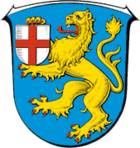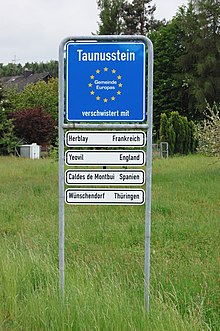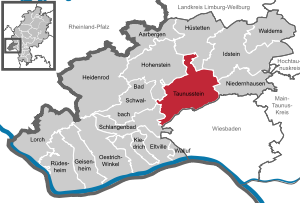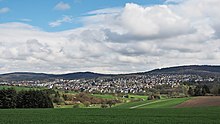Taunusstein
| coat of arms | Germany map | |
|---|---|---|

|
Coordinates: 50 ° 9 ′ N , 8 ° 10 ′ E |
|
| Basic data | ||
| State : | Hesse | |
| Administrative region : | Darmstadt | |
| County : | Rheingau-Taunus district | |
| Height : | 393 m above sea level NHN | |
| Area : | 67.03 km 2 | |
| Residents: | 30,050 (Dec. 31, 2019) | |
| Population density : | 448 inhabitants per km 2 | |
| Postal code : | 65232 | |
| Area code : | 06128 | |
| License plate : | RÜD, SWA | |
| Community key : | 06 4 39 015 | |
| LOCODE : | DE TSN | |
| City structure: | 10 districts | |
City administration address : |
Aarstrasse 150 65232 Taunusstein |
|
| Website : | ||
| Mayor : | Sandro Zehner ( CDU ) | |
| Location of the city of Taunusstein in the Rheingau-Taunus district | ||
With about 30,000 inhabitants, Taunusstein is the largest city in the Rheingau-Taunus district in southern Hesse , nine kilometers northwest of the state capital Wiesbaden . The seat of the city administration is in the Hahn district .
geography
Neighboring communities
| Hohenstein | Hünstetten | Idstein |
| Bad Schwalbach |

|
Niedernhausen |
| Snake bath | Wiesbaden |
structure
Taunusstein consists of ten districts:
| district | Residents as of June 2020 |
|---|---|
| Bleidenstadt | 8079 |
| Rooster | 7287 |
| Labor pains | 7142 |
| Neuhof | 3490 |
| Seitzenhahn | 1347 |
| Orlen | 1206 |
| Wingsbach | 737 |
| Niederlibbach | 547 |
| Hambach | 389 |
| Watzhahn | 292 |
| total | 30,516 |
history
The city of Taunusstein was created in the course of the regional reform in Hesse on October 1st, 1971 through the voluntary merger of the formerly independent communities Bleidenstadt, Hahn, Neuhof, Seitzenhahn, Watzhahn and Wehen. With the merger, Taunusstein was granted city rights. On July 1, 1972, the municipalities Hambach, Niederlibbach, Orlen and Wingsbach were in the city Taunusstein voluntarily incorporated . Local districts with local councils and local councilors were formed for all city districts .
In 1991, the Dr.-Peter-Nikolaus-Platz, named after the long-time mayor of Taunusstein, was inaugurated in the Hahn district. He is surrounded by the community center "Taunus" the Catholic Church Center of St. John Nepomuk and the new town hall and forms with the bundling of these public functions the new city center. The community center "Taunus" was opened in 1989, the church center in 1991, both designed by the Hamburg architect Bernhard Hirche , who also created the urban planning concept for the new town center. The town hall designed by the Hohenstein architect Armin Bielak, however, could not be inaugurated until 1998.
Population development
On December 31 of the respective year (until 1990 with secondary residences, thereafter only main residence)
|
||||||||||||||||||||||||||
|
Religious communities
- Evangelical and Catholic churches in almost all parts of the city
- Foursquare Germany , a free church
- Bahai community in Hahn
- New Apostolic Church in Neuhof
- Kingdom Hall of Jehovah's Witnesses in Neuhof
- Ditib Kadir Mosque in Hahn
politics
City Council
The city council is the highest body of the city. Its political composition is determined every five years in local elections by the city's electorate. Whoever has reached the age of 18 and is a German citizen within the meaning of the Basic Law or a citizen of one of the other member states of the European Union may vote. Everyone has to have been registered in the city for at least three months.
The local elections on March 6, 2016 produced the following results, compared to previous local elections:
| Parties and constituencies | 2016 |
 |
2011 |
 |
2006 |
 |
2001 |
 |
1997 |
 |
|||||
|---|---|---|---|---|---|---|---|---|---|---|---|---|---|---|---|
| Share a | Seats | Share a | Seats | Share a | Seats | Share a | Seats | Share a | Seats | ||||||
| Christian Democratic Union of Germany | CDU | 39.9 | 18th | 35.1 | 16 | 40.7 | 18th | 37.1 | 17th | 28.5 | 13 | ||||
| Social Democratic Party of Germany | SPD | 22.7 | 10 | 30.3 | 14th | 30.2 | 14th | 37.2 | 17th | 36.9 | 17th | ||||
| Free community of voters | FWG | 15.3 | 7th | 7.5 | 3 | 8.7 | 4th | 7.7 | 3 | 10.2 | 5 | ||||
| Alliance 90 / The Greens | GREEN | 12.0 | 5 | 21.1 | 9 | 14.4 | 6th | 10.8 | 5 | 11.5 | 5 | ||||
| Free Democratic Party | FDP | 10.1 | 5 | 6.0 | 3 | 6.1 | 3 | 7.2 | 3 | 5.2 | 2 | ||||
| The Republicans | REP | - | - | - | - | - | - | - | - | 7.7 | 3 | ||||
| percentage of invalid votes | 3.5 | 3.7 | 3.4 | 2.7 | 2.9 | ||||||||||
| Total seats | 45 | 45 | 45 | 45 | 45 | ||||||||||
| voter turnout | 50.4% | 48.9% | 46.3% | 51.2% | 62.1% | ||||||||||
45 city councilors and the city's local councils had to be elected for the legislative period from April 1, 2016 to March 31, 2021. Of the 22,657 eligible voters, 11,411 went to the polls. As a result, the turnout increased from 48.9% in 2011 to 50.4% in 2016.
mayor
The mayor Sandro Zehner (CDU) was elected on September 22, 2013 in the first ballot with a turnout of 73.2% with 60.5% of the votes. On May 26, 2019, Zehner, who this time was the only candidate, was re-elected with 79.1%. The turnout was 58.8%.
Finances
The debt of the city of Taunusstein as of December 31, 2012 was EUR 75,664,097. This corresponds to 2669 euros per inhabitant. Taunusstein was one of the first municipalities in Germany to voluntarily introduce a so-called sustainability statute for the area of urban finances, through which the city strives to prevent financial burdens on future generations and to reduce debt.
coat of arms
The city's coat of arms shows a golden lion on a blue background, carrying a shield with a red cross on a silver background in its paws. With the golden lion, the coat of arms recalls the centuries-long rule of the Counts and Princes of Nassau and at the same time takes up the tradition of the coat of arms of the Nassau official seat of Wehen and the communities of Hahn and Seitzenhahn, all of which had a gold lion or lion's head. The cross is an attribute of St. Ferrutius , the patron saint of the Bleidenstadt monastery. This monastery was founded in the 8th century and has made great contributions to Christianity and culture in the area around the upper Aar over the centuries. The former municipality of Bleidenstadt already had this cross in its coat of arms.
The official blazon reads: "In blue a red armored golden lion, in its paws a silver shield with a continuous red cross."
Town twinning

Taunusstein maintains partnership relationships with:
-
 Herblay-sur-Seine , France (since 1973)
Herblay-sur-Seine , France (since 1973) -
 Yeovil , UK (since 1987)
Yeovil , UK (since 1987) -
 Caldes de Montbui , Spain (since 1989)
Caldes de Montbui , Spain (since 1989) -
 Wünschendorf / Elster ( district of Greiz ), Germany (since 1991)
Wünschendorf / Elster ( district of Greiz ), Germany (since 1991)
Economy and Infrastructure
traffic
train
The Hahn-Wehen station and the Bleidenstadt stop are on the route of the Aartalbahn, which has not been in operation since 2008 . As part of the discontinued Wiesbaden Stadtbahn project , a local transport connection to the state capital was planned.
Omnibuses
The bus traffic in Taunusstein is largely planned and commissioned by the Rheingau-Taunus-Verkehrsgesellschaft . However , lines awarded by the Rhein-Main-Verkehrsverbund also touch the city.
In Taunusstein there are two transfer nodes in the integral cycle timetable , Hahn bus station and Neuhof Mitte. A journey from both nodes to Wiesbaden Central Station takes around 25 minutes.
Other lines run from the Hahn bus station in the direction of Hohenstein and Aarbergen , Bad Schwalbach and the Taunusstein districts of Seitzenhahn and Watzhahn. From Neuhof Mitte there are connections in the direction of Idstein , Niedernhausen , Orlen and an express bus to Limburg an der Lahn . Several bus lines operate between the two transfer points, which take around 20 minutes for the route.
Road traffic

The urban area is crossed lengthways by the B 275 . Connections to Wiesbaden are made by the B 417 (Neuhof / Wehen) and the B 54 (Hahn). The nearest motorway junction is the junction Idstein the A 3 from twelve kilometers from the district Hahn.
Taunusstein is one of the communities in which, to improve the mobility of people without a car (such as the elderly, young people), a number of passenger benches have been set up as a supplement to local public transport . This enables, for example, additional, free connections to and from Watzhahn and Bleidenstadt.
air traffic
The nearest international airport is Frankfurt am Main Airport, around 40 km away. The nearest commercial airport is the Mainz Finthen Airport is 26 km away.
Established businesses
- Brita GmbH water filtration in Neuhof
- Feinkost Dittmann in Neuhof
- Institute Fresenius in Neuhof
- Omicron NanoTechnology in Neuhof
- Hessapp (part of FFG ) in Hahn
Educational institutions
- Rainbow School - Primary School in Bleidenstadt
- Silberbachschule - primary school in Wehen
- Sun school - elementary school in Neuhof
- Integrated comprehensive school "Obere Aar" in the Hahn school center (with elementary level)
- Taunusstein High School in Bleidenstadt
- Vocational schools in Untertaunus in the Hahn school center
- Obermayr Europa-Schule Taunusstein - bilingual primary school, bilingual secondary school and bilingual grammar school in Neuhof
Leisure and sports facilities
- Stadium am Halberg in Wehen, former home stadium of the 1st team of SV Wehen
- Outdoor swimming pool in Hahn
- Silberbachhalle in labor
- Aartalhalle in Neuhof
- Community center / village community center in every district
- Sports fields in Bleidenstadt, Hahn, Neuhof, Orlen, Seitzenhahn, Wehen (all artificial turf fields)
- Sports and youth center in Bleidenstadt
- Soccer hall in Bleidenstadt
- Boules in Orlen and Neuhof
- Football fields in almost every district
Culture and sights
museum
In 1995 the Taunusstein City Museum was set up with permanent rooms in Wehen Castle . Since then, the main focus has been on a permanent exhibition on recent regional history, which also reports on the state of Taunussstein during, before and after the Second World War . These are predominantly depictions of everyday culture in the first half of the 20th century. The exhibitions in the “Art in the Castle” series, with which contemporary art, and not just the local area, is offered a forum in Taunusstein, form a second and equal pillar.
Buildings
- Wehen Castle
- Used, among other things, as a widow's seat and hunting lodge. The Taunussteiner Museum is located there today.
- Evangelical Church Labor
- The listed Evangelical Church Wehen was built in 1810–1812 using stones from the old city fortifications (city wall, Obertorturm) on the site of the former princely hunting arsenal according to plans by the ducal Nassau building director Carl Florian Goetz from Wiesbaden . The historic Voigt organ of the Ev. The Wehen church is one of the few original instruments made by the Wiesbaden organ builder Heinrich Voigt . In October 1999 it was restored and returned to its original condition.
- Former Wehen School
- Built around 1900, a building in transition from the early days to Art Nouveau.
- Former monastery with church, Bleidenstadt
- (today the parish church of the Catholic parish "St. Ferrutius"). Above the main portal of the church is the statue of St. Ferrutius (patron saint) from 1718, in the building a sandstone wall tabernacle from the High Gothic period built into the choir , a baptismal font from 1696, a late Baroque figure of the Madonna and an organ with baroque renovation. Two bells from 1309 and 1411 in the tower.
- Evangelical Church, Bleidenstadt
- (Former Catholic parish church "St. Peter auf dem Berg", given to the new Protestant community as a church after 1530) with the oldest stone monument in the district, a grave slab of the pastor Johannes von Spangenberg, who died in 1363. The lower part of the tower is of Romanesque origin. A decorative rose window with ornaments made of sandstone is located above the entrance in the east.
- Fort Zugmantel , Orlen
- A former Roman cohort fort on the western Taunus section of the Upper German Limes , which has been a UNESCO World Heritage Site since 2005 . The ground monument , which can still be clearly seen above ground, is located in a forest edge area of Taunusstein- Orlen in the Hessian Rheingau-Taunus district .
Jewish cemetery in labor
The Jewish cemetery on Halberg in Wehen is about as old as the settlement itself.
In 1329, Count Gerlach von Nassau-Weilburg ordered the settlement of Jews . The tombstones from that time no longer exist. The oldest still standing is from 1694. Today there are 58 visible graves in the cemetery. Jews from Wiesbaden were also buried in the Wehner Jewish cemetery until 1749. In 1726, the Jews applied for a wall to be built around the cemetery, which, however, was prohibited because the Jewish cemetery could not be more beautiful than the Christian one. So they just dug a trench. After 1933 there were also burials, but it was forbidden to put up tombstones.
Regular events
In total there are in Taunusstein six regularly scheduled parish fairs ( notches ): The Bleischter notch that Orlener notch that Hahner notch that Weher notch and the Wings Bacher notch and the Neuhofer notch .
In addition, there is the Orlener Markt and the Weher Markt , whereby it is a tradition for the latter that the Wehner companies go to the market in the morning with their employees for a morning pint. There is also the Hahn Center Festival . There are also four Christmas markets: The Taunusstein Christmas Market , the Hahn am Forsthaus Altenstein Forest Christmas Market , the Wingsbach Christmas Market and, since 2004, the Christmas market in Orlen , the proceeds of which are donated to a good cause.
The TIGA ( Taunussteiner Industrial and Commercial Exhibition ) also takes place every two years in the even years .
Personalities
- Emil Erlenmeyer (1825–1909), chemist, born in Wehen
- Carl Friedrich Emil von Ibell (1780–1834), District President of Nassau and Hessen-Homburg , born in Wehen
- Holger Back (* 1957), glider pilot and competitive athlete
Individual evidence
- ↑ Hessian State Statistical Office: Population status on December 31, 2019 (districts and urban districts as well as municipalities, population figures based on the 2011 census) ( help ).
- ↑ Taunusstein population statistics
- ^ Municipal reform in Hesse: mergers and integrations of municipalities from June 21, 1972 . In: The Hessian Minister of the Interior (ed.): State Gazette for the State of Hesse. 1972 No. 28 , p. 1197 , point 851, paragraph 7. ( Online at the information system of the Hessian State Parliament [PDF; 4.4 MB ]).
- ^ Federal Statistical Office (ed.): Historical municipality directory for the Federal Republic of Germany. Name, border and key number changes in municipalities, counties and administrative districts from May 27, 1970 to December 31, 1982 . W. Kohlhammer, Stuttgart / Mainz 1983, ISBN 3-17-003263-1 , p. 377-378 .
- ↑ main statute. (PDF; 90 kB) §; 5. In: Website. City of Taunusstein, accessed February 2019 .
- ^ Bernhard Hirche, architect BDA - city center Taunusstein-Mitte
- ↑ 1961 and 1970: census results on June 6, 1961 and May 27, 1970 including the places that were later incorporated, see Federal Statistical Office (ed.): Historical municipality directory for the Federal Republic of Germany. Name, border and key number changes in municipalities, counties and administrative districts from May 27, 1970 to December 31, 1982 . W. Kohlhammer, Stuttgart / Mainz 1983, ISBN 3-17-003263-1 , p. 378 .
- ↑ As of May 2018
- ^ NAK Taunusstein
- ^ Mosque search Taunusstein
- ^ Result of the municipal election on March 6, 2016. Hessian State Statistical Office, accessed in April 2016 .
- ↑ Hessian State Statistical Office: Results of the municipal elections of 2011 and 2006
- ↑ Hessian Statistical Office: Results of the municipal elections of 2001 and 1997
- ↑ https://www.hessenschau.de/politik/wahlen/direktwahlen/verbindungen-buergermeisterwahl-taunusstein-260519,direktwahl-taunusstein-100.html
- ↑ Federal and State Statistical Offices: Integrated Debt of the Municipalities and Municipal Associations - Proportional model calculation for the inter-municipal comparison - as of December 31, 2012 - joint publication
- ↑ Sustainability Statutes of the City of Taunusstein , accessed on August 30, 2014
- ↑ State Office for the Preservation of Monuments Hesse (ed.): Evangelical Parish Church Wehen In: DenkXweb, online edition of cultural monuments in Hesse
- ↑ Wehen Jewish cemetery . Jewish graves in Hesse. In: Landesgeschichtliches Informationssystem Hessen (LAGIS).
- ^ Jewish cemeteries in the Rheingau-Taunus district of Alemannia Judaica - Working group for research into the history of Jews in southern Germany and the surrounding area
literature
- Literature on Taunusstein in the Hessian Bibliography
- Publications about Taunusstein in the catalog of the German National Library
Web links
|
Further content in the sister projects of Wikipedia:
|
||
|
|
Commons | - multimedia content |
- Internet presence of the city of Taunusstein
- Taunusstein, Rheingau-Taunus-Kreis. Historical local dictionary for Hessen. In: Landesgeschichtliches Informationssystem Hessen (LAGIS).
- Link catalog on Taunusstein at curlie.org (formerly DMOZ )











